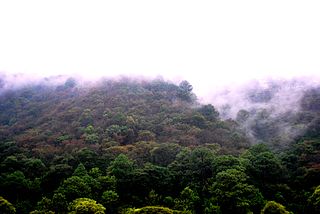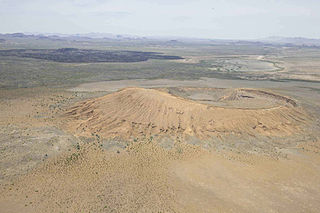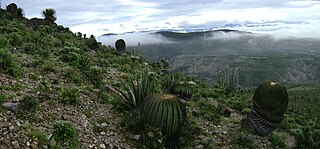Amacuzac is a city in the Mexican state of Morelos. The name means In the River of Yellow Amates. Amacuzac stands at 18°36′N99°23′W, at a mean height of 900 meters above sea level. The city serves as the municipal seat for the surrounding municipality of the same name. The municipality reported 17,772 inhabitants in the year 2015 census and covers a total surface area of 125 km². The 2020 census reported 17,598 inhabitants in the municipality and 5,575 in the city of Amacuzac.

Puente de Ixtla is a city in the Mexican state of Morelos. It stands at 18°37′01″N99°19′23″W. The city serves as the municipal seat for the surrounding municipality of the same name. The municipality reported 66,435 inhabitants in the year 2015 census.
Tepalcingo is a town in the Mexican state of Morelos. It at 18°26′N98°18′W. The name Nahuatl root tekpa-tl (flint), tzintli, tzinco, so in sum it means tekpatzinko "down or behind the flints".

18°37′44″N90°09′37″WTlaquiltenango is a city in the Mexican state of Morelos. It is 151.6 kilometres (94.2 mi) south of Mexico city and 60.1 kilometres (37.3 mi) southeast of Cuernavaca, the state capital via Mexican Federal Highway 95D.

The Sierra de la Laguna pine–oak forests are a subtropical coniferous forest ecoregion, found in the Sierra de la Laguna mountain range at the southern tip of the Baja California Peninsula, Mexico.
Huautla is a small town in the Mexican state of Morelos, in the municipality of Tlaquiltenango. Revolutionary General Gildardo Magaña Cerda (1891-1939) was proclaimed successor of Emiliano Zapata to the leadership of the Liberation Army of the South near this town on 1919-09-04.

The Trans-Mexican Volcanic Belt pine–oak forests is a subtropical coniferous forest ecoregion of the Trans-Mexican Volcanic Belt of central Mexico.

The Balsas dry forests is a tropical dry broadleaf forest ecoregion located in western and central Mexico.

The Central American pine–oak forests is a tropical and subtropical coniferous forests ecoregion in the mountains of northern Central America and Chiapas state in southern Mexico.
The Amacuzac River is located in Morelos, Mexico and it is the most important river of this state being approximately 60 km long. It originates in the slopes of Nevado de Toluca and empties southwards into the Balsas River. It bisects the Sierra de Huautla, and a portion of the river is in the Sierra de Huautla Biosphere Reserve. The Amacuzac River is known for its rapids which support extreme sports.

El Pinacate y Gran Desierto de Altar Biosphere Reserve is a biosphere reserve and UNESCO World Heritage Site managed by the federal government of Mexico, specifically by Secretariat of the Environment and Natural Resources, in collaboration with the state governments of Sonora and the Tohono O'odham.

The Yucatán moist forests are an ecoregion of the tropical and subtropical moist broadleaf forests biome, as defined by the World Wildlife Fund.
El Jabalí Flora and Fauna Protection Area is a protected natural area located in Colima State, México. It covers an area of 51.79 km2, which includes forests and several natural lakes.

The Tehuacán-Cuicatlán biosphere reserve is a protected natural area located in southeastern Mexico. Its name derives from its two main locations: Cuicatlán and Tehuacán, in the latter are their administrative offices, covers 490,186 hectares distributed among 21 municipalities in the state of Puebla and Oaxaca.

The Jalisco dry forests is a tropical dry broadleaf forest ecoregion in southwestern Mexico.

The Sierra de Álamos–Río Cuchujaqui Flora and Fauna Protection Area, also known as the Sierra de Álamos–Río Cuchujaqui Biosphere Reserve, is a protected area and biosphere reserve in western Mexico. It is located in southeastern Sonora state, along the boundary with Sinaloa and Chihuahua states.
La Michilía Biosphere Reserve is a protected area in northwestern Mexico. It is located in the Sierra Madre Occidental range in southern Durango state.

The Sierra de San Juan Biosphere Reserve is a protected area in Nayarit state of western Mexico. It was established in 2003, and has an area of 198.01 km2. It lies just southwest of the city of Tepic. It protects a portion of the Sierra de San Juan, a mountain range which lies between Tepic and the Pacific Ocean.

La Primavera Biosphere Reserve, also known as La Primavera Flora and Fauna Protection Area, is a protected natural area in western Mexico. It is located in the state of Jalisco, immediately west of the city of Guadalajara.

La Sepultura is a biosphere reserve in southern Mexico. It protects a portion of the Sierra Madre de Chiapas range in the state of Chiapas.















